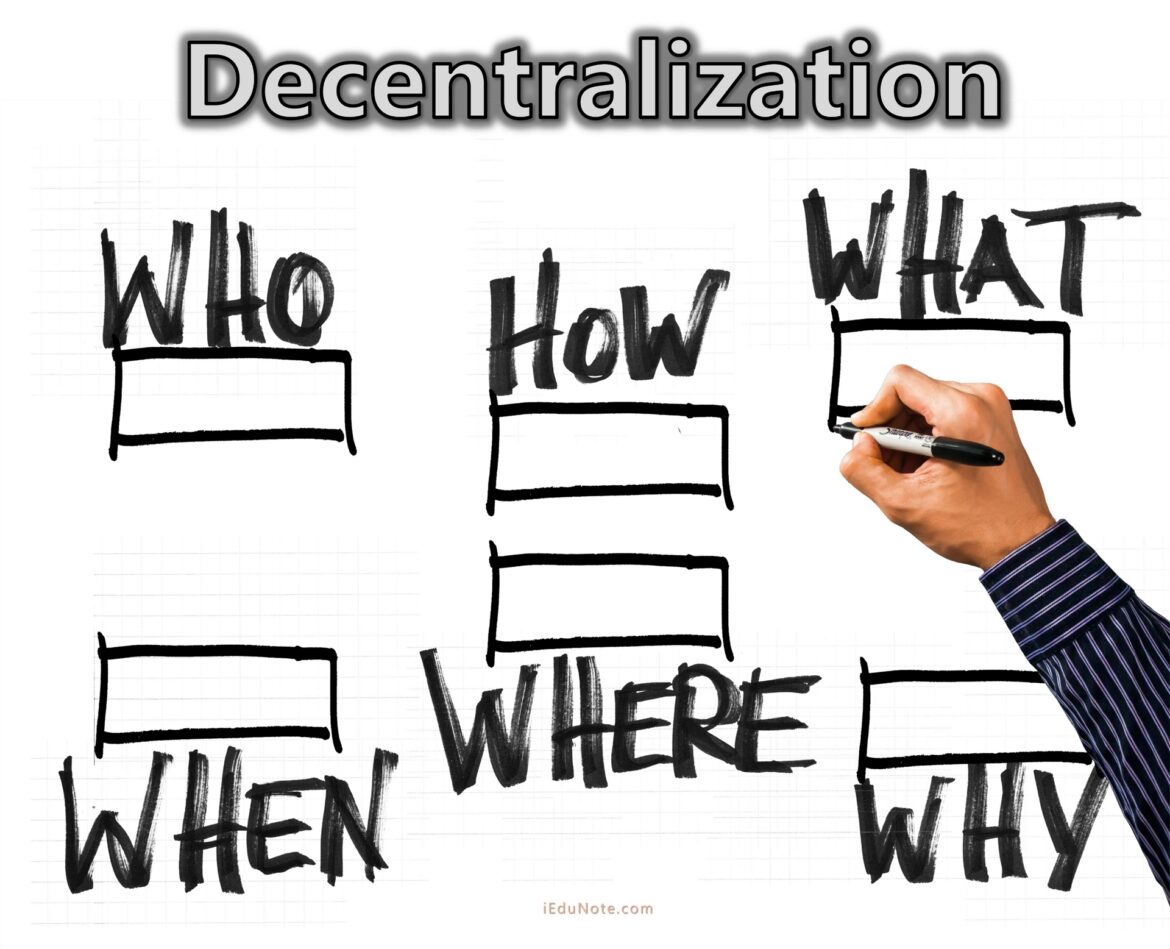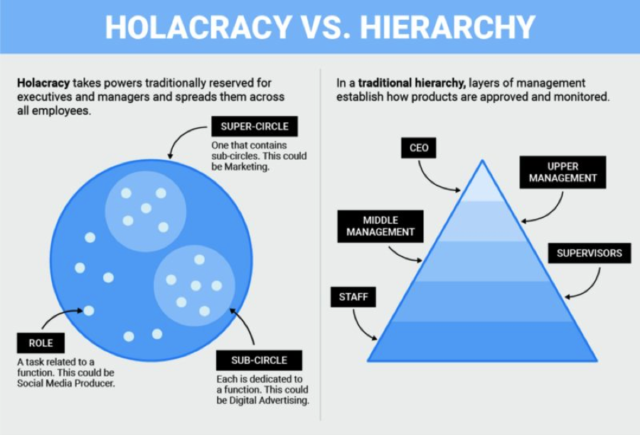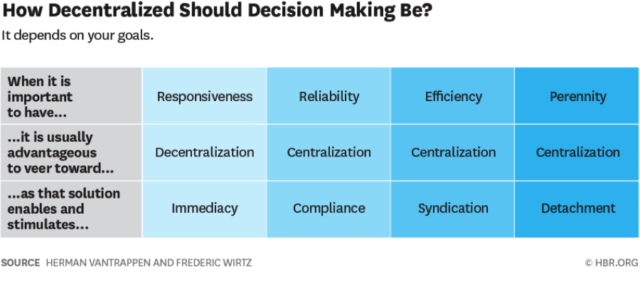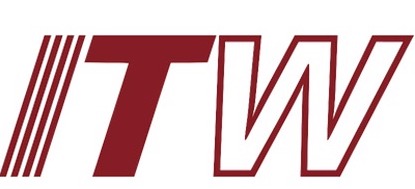
Should Your Organization Be Decentralized?
As Henry Mintzberg, author of The Structuring of Organizations, writes, “The words centralization and decentralization have been bandied about for as long as anyone has cared to write about organizations.” And that is a pretty long time, at least since 400 B.C., when Jethro advised Moses to distribute responsibility to various levels in the hierarchy.
What is Decentralization?
What does decentralization actually mean? As the Business Dictionary defines it, decentralization is the “Transfer of decision making power and assignment of accountability and responsibility for results. It is accompanied by delegation of commensurate authority to individuals or units at all levels of an organization even those far removed from headquarters or other centers of power.”
Decentralization, sometimes called distributed leadership, is a step away from a more hierarchal structure, which has long been the standard organizational structure. However, organizations from startups to multinational corporations are beginning to adapt flatter, more egalitarian structures. Why? Because as a response to changing times.
Organizations tend to move back and forth between being more centralized and more decentralized, depending on an array of societal forces. For example, emerging markets could create a need for a decentralized organization that makes decisions based on the market needs instead of headquarter needs.
When it comes to decentralization, there are two words you should know: Holacracy and Hierarchy. Take a look at this graphic for a visual representation:

HOLACRACY VS. HIERARCHY
Holacracy takes powers traditionally reserved for executives and managers and spreads them across all employees. On the other side of the spectrum, we have traditional hierarchy, where layers of management establish how products are approved and monitored. Holacracy is a prime example of decentralization and clearly promotes distributed leadership.
Here’s What Decentralization Looks Like
A decentralized organization may have a hierarchy, but decision-making is delegated to individual teams, empowering them to take action on their own. In fact, the decision-making happens as low on the chain of command as possible, as long as teams make sure their actions align with an agreed-upon vision and broader plan. Divisions of a decentralized company might independently handle all aspects of their operations or only particular ones. A more extreme level of decentralization that aims to eliminate hierarchy altogether usually won’t work for a massive corporation.
It’s important to note that no company is fully centralized or decentralized. Instead, there are degrees of both, depending on its size, culture, and strategy.
Examples of Organizations That Are a Combination of Centralized and Decentralized
To understand how centralization and decentralization can be seen in one organization, let’s take a look at three real world examples:

Subway
Subway gives local stores control over hiring, but a centralized headquarters makes decisions about things such as menu and marketing.

Johnson & Johnson
Johnson & Johnson, well known for its decentralized structure, has over 200 units that function autonomously. Some focus on particular components of a product, requiring cooperation between such units.

Johnson & Johnson
Johnson & Johnson, well known for its decentralized structure, has over 200 units that function autonomously. Some focus on particular components of a product, requiring cooperation between such units.
Why Decentralize?
There are several benefits of decentralization. There are also challenges. Here are some examples of both:
BENEFITS OF DECENTRALIZATION
- Flexibility
- Information-processing ability
- Increased Morale
- Development of expertise
- Error mitigation
- Ability to pinpoint strengths and weaknesses
- Reliance on local insight
- Ability to cope with adversity
CHALLENGES OF DECENTRALIZATION
- Implementing change
- Coordination between teams
- Redundancy of roles
- Social Impacts
Organizations have to take a close look at the benefits and challenges to see if decentralizing would make a positive impact. However, sometimes a pivot is needed after trying it out. For example, Zappos made a move toward holacracy, which replaces centralized hierarchy by eliminating titles and bosses. However, employees began leaving in droves because of confusion and dwindling motivation since there was no perceived career ladder.
How can you tell if your organization would benefit from decentralization? Herman Vantrappen and Frederic Wirtz say it depends on your goals. The table below gives some examples of goals and whether a more centralized or decentralized approach would be most successful.

They explain:
When it’s important to have responsiveness, it’s usually advantageous to veer toward decentralization, as that solution enables and stimulates immediacy.
When it’s important to have reliability, it’s usually advantageous to veer toward centralization, as that solution enables and stimulates compliance.
When it’s important to have efficiency, it’s usually advantageous to veer toward centralization, as that solution enables and stimulates syndication.
When it’s important to have perennity, it’s usually advantageous to veer toward centralization, as that solution enables and stimulates detachment.
Real World Examples of Decentralization
ILLINOIS TOOL WORKS (ITW)

Though ITW has $6 billion in sales, it is broken into 400 units with an average revenue of just $15 million. Each unit has its own general manager, who runs the division as if it were his/her own business, as long as that unit is outperforming everyone else in that particular market. There aren’t any companywide, preset benchmark profit goals. Instead, top management imposes standards based on a particular unit’s competition. Each general manager must usually submit to grilling about six times a year by one of seven executive vice presidents. When a unit starts to outperform — or underperform — the competition, it is split into more pieces, usually along tightly focused product lines.
Outcome: ITW’s ten-year average annual earnings growth of 16% and five-year total return on capital of 19% exceed even those of capital goods heavyweight General Electric.
KRAFT FOODS

Kraft Foods is combination of businesses that have been bought and sold over the course of 25 years. Philip Morris bought General Foods in 1985, then bought Kraft in 1988. Oscar Mayer, Nabisco, and Jacobs Suchard in Europe all became part of Kraft through acquisitions.
Instead of letting all of them have their own functions and operate as business units within a holding company, there was a centralized model with very strong functional control.
This led to all the group companies becoming increasingly disempowered and disenfranchised. The earnings were declining and the company was not responding to changes in the environment quickly enough. It became very clear that the company had to go back and create more accountable business units. It was about pushing decision making down the hierarchy, deploying resources where they were needed, and giving leaders more freedom to act.
In response, Kraft Foods created a new, more decentralized, business model. This became a blueprint for change in an organization that was quickly plummeting.
Outcome: The centralized structure did not work. Luckily, they were able to pivot to a more decentralized structure, which had great results. Former CEO Irene Rosenfeld explains it best:
Rewiring our organization was one of the four key strategies of our three-year turnaround plan to restore the company to sustainable, long-term growth. To achieve this, we had to essentially dismantle the existing organizational matrix and replace it with a decentralized structure that gave our newly reorganized business units more direct lines of responsibility.
I encourage you to think about your own organization. Is it more centralized or decentralized? If centralized, do you think decentralization would help the organizational culture and performance? If decentralized, do you centralization would help organizational culture and performance? I’d love to hear your inside view.
Leave a comment below, send us an email, or find us on Twitter.


Leave A Comment